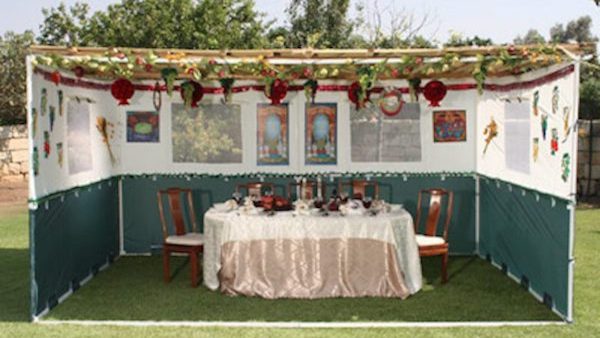The Jewish festival of Sukkot begins at sundown this coming Friday, 10/2. Sukkot is one of the three most important Jewish festivals (the other two are Passover and Shavuot). I know what some of you are thinking, and the answer is no, the other Festivals we celebrate, like Chanukah, and Purim were created by ancient Rabbis. The other major Jewish festival, my birthday, was created by a blogger looking for attention. Those three “biggie” festivals are the only ones ordained by God in the Torah, as are Rosh Hashana and Yom Kippur. It is important to note that the five-day period after Yom Kippur leading up to Sukkot are the most dangerous days in the Jewish calendar. It’s not because God starts zapping those who didn’t make it into the book or iPad of life on the Day of Atonement. It’s dangerous because it’s the one time each year one can find some Jewish men using tools–they are using the tools to build a Sukkah for the Holiday.
During biblical times the Children of Israel would come to Jerusalem from all over the holy land to celebrate those three festivals. Sukkot must have been a rough one for the Jews who lived far from Jerusalem because they were required to be at the Holy Temple for Rosh Hashana, Yom Kippur, and Sukkot. That’s more than three weeks on the road, and it usually falls during the MLB playoffs.
The celebration of Sukkot is commanded in chapter 24, verse 34, in the third book of the Torah, Vayikra (known by Gentiles as Leviticus). Jews call each book of the Torah by the first words in the book. In the case of the third book, it’s Vayikra, which means ‘And He called.” The “He” is the big guy upstairs. Anyway, that verse says
Speak to the children of Israel, saying: On the fifteenth day of this seventh month, is the Festival of Sukkot, a seven day period to the Lord.
Oh, wait, I forgot to tell you. Rosh Hashana, the Jewish New Year, is the first day of Tishrei, the Seventh month in the Jewish calendar (when God created the universe). In the Jewish tradition, it is one fo the four New Years.
Along with Rosh HaShana are:
- The 15th of Shevat, also known as Tu B’Shevat– is the new year for trees. In the Torah, it says we are not to eat a tree’s fruit until it is three years or three Tu B’Shevat’s old.
- The first of Nisan (which is the first month of the Jewish calendar year). Passover is 15 days later. It is said seventy individuals went into Egypt to become slaves, and we came out as one people. Nisan celebrates becoming one people that unification earned our redemption from Egypt. The first of Nisan is also a reminder to start adding fiber to our diet because of all that matzoh, we are about to eat eight days of Matzoh two weeks later during Passover, which is the equivalent of pouring cement into our large intestines.
- The last new year, the first of Elul, is the New Year for the tithing of cattle. The tithe for cattle had to be made from cattle born in the same fiscal year, between the first of Elul one year and the next.
Back to Sukkot– part of the holiday observance is to create a flimsy “structure” with a semi-see-through roof–the roof must be built from something that grows in the ground (NO, not mold or insects). The structure is called a Sukkah (see picture on top of this post). My friend Eddie built his Sukkah from scratch using raw materials. He is what’s known in Hebrew as שוויצר, which translates as “freaking show-off.” As for me, I put together a pre-fabricated Sukkah, which sadly doesn’t save my fingers from injury when trying to pound the metal frame together.
During Sukkot, we eat, entertain, and some even sleep in this structure. My favorite part of the holiday is inviting over friends and hanging out in the Sukkah. It seems less pressured than when they come into the house and hang out because if we drop something, it doesn’t matter. We are outside. And this year, under COVID restrictions, we can finally have friends over providing our Sukkahs are big. We are outside and can socially distance.
BTW if you are invited to hang out in a Jewish friend’s Sukkah, please don’t say you are celebrating nomadic hut appreciation week–it’s really not nice.
The holiday reminds us of the life of the ancient Israelites wandering in the wilderness for 40 years living in structures like this (and arguing over whether or not Moses should stop at a gas station to ask for directions). More importantly, existing in this kind of flimsy structure reminds us of the frailty and transience of life and, in the end, our necessary dependence on God to protect us.
Sukkot has a lot of significant meanings, perhaps the best one for today’s world is the fact that it is the Holiday when we pray for the rest of the world, and considering how lousy 2020 has been, that’s a good thing. In Biblical times, the High Priest used to make 70 sacrifices during Sukkot, representing one prayer for each of the 70 nations of the world. I would imagine that the five days before Sukkot was a period of prayer for the 70 cows about to be sacrificed.
By the way, do you want to know how some Jews get lights for our Sukkahs? Have you ever gone into a Walmart 2-3 weeks after Christmas? The store sells left-over Christmas lights for $1.99 a case? The guy you see in the parking lot wheeling the extra-large shopping cart filled with boxes of Christmas lights might very well be a Jew who bought them to light the Sukkah. I guess some can say Sukkot is the one Jewish holiday with the “Christmas Spirit.”
Sukkot is a happy holiday. It is referred to in Hebrew as Yom Simchateinu (the day of our rejoicing) or Z’ man Simchateinu (the time of our rejoicing). Our happiness has nothing to do with the fact that we are allowed to eat (after fasting on Yom Kippur). Nor is it that we’ve been able to put down our hand tools without any significant damage to our bodies (sometimes).
BTW some historians believe that the first Thanksgiving was modeled after Sukkot.
From building the Sukkah, “living in it’ for a week, to tearing it down, Sukkot is a fun, and joyous time we share with family and friends, both Jewish and Gentile.
We also invite ancient Jewish figures into our Sukkah, one different every night. These figures are called Ushpizin (righteous guests). They include Abraham, Isaac, Jacob, Joseph, Moses, Aaron, and David. Don’t worry, these guys don’t eat or drink that much. They only come in spirit. I suspect we don’t invite the Prophet Elijah because he is still a bit tipsy from having a glass of wine at every Passover seder.

A Lulav
Oh, and the reason it’s the five days after Yom Kippur that’s the most dangerous period in the Jewish calendar? It’s an interesting story. In Jewish tradition, we do not start preparing for any holiday before the previous one has ended. It’s not a superstition thing. We need to focus all of our attention on the holiday at hand before we can move on to the next. This is doubly important when the holiday before Yom Kippur when we are praying extra hard to make a personal connection with God.
On the five days after Yom Kippur, Jews all across the world start building their Sukkahs. The problem is that most Jews aren’t great with tools. And for many of us (like yours truly), the last time we picked up a tool or stepped on a ladder was when we took down last year’s Sukkah. So you can probably have a belly laugh if you peek out your window and observe your Jewish neighbor building their Sukkah–it is the construction equivalent of the Keystone Kops, and you can hear them cussing in ancient foreign tongues. One of my neighbors even swears in Klingon.
Sukkot is celebrated for eight days (sort of) in the diaspora and seven in Israel. The reason for the “sort of” is that the last two days are actually different holidays Shemini Atzeret and Simcha Torah (more on that later).
Shemini Atzeret celebrates our love for God, his relationship with the Jewish people, and adds a special prayer for rain (Geshem). The rain prayer is for the holy land. It’s not needed here in the U.S. because, during Sukkot, there is usually a strong rainstorm/windstorm that blows our Sukkah from our patio onto the grass. Perhaps it’s God’s way of making all Jews everywhere feel like N.Y. Jets fans—everything messed up at the last minute.
Simcha Torah is a fun day. Jews read the last chapters of the Torah and then the first chapters. SPOILER ALERT: The Torah ends with Moses dying. Judaism teaches that studying Torah is a continual lifetime process, which is why we go straigt from the death of Moses right into the Torah’s baseball reference, Genesis 1:1, “In The Big Inning.” Simcha Torah is a fun gala where we sing, dance with the Torah Scrolls, wave flags, etc. (and drink). With this year’s prohibition against crowds in houses of worship, I’m pretty sure that the Simcha Torah celebration will not be as much fun (plus we will have to drink the whiskey at home).
There’s one more important part of the Sukkot celebration, the Lulav, and the Etrog, also known as the four species. The lulav is a palm branch, joined with myrtle and willow branches, and the Etrog is citron fruit. It kind of looks like a lemon that suffers from boils. The four species are held and waved during various parts of the synagogue service on Sukkot.

The Very Ugly Etrog Fruit
Sukkot starts Friday night at sundown. Maybe every one of any faith can join us in praying for the safety of the people in all nations. Especially praying that God eliminates the COVID mess.
BTW you don’t have to be Jewish to pray for the world—as Kinky Freedman, the Jewish country music star, would say, “May the God of your choice bless you.”
And as we say in the momma loshen (mother tongue-Yiddish): Have a Gut Yuntif (a good holiday).
https://lidblog1.wpenginepowered.com
gentiles guide Sukkot
gentiles guide Sukkot
gentiles guide Sukkot
gentiles guide Sukkot






